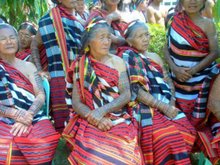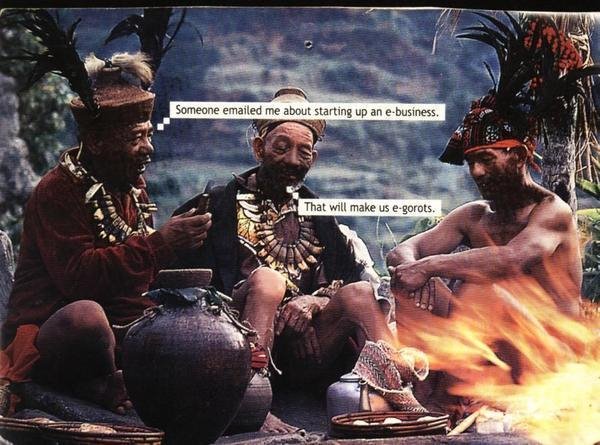
This film was one of two films featured in The 8th Asian Film Symposium in the category of Philippine Medium Length Films entries, sponsored by The Substation, Singapore. It was shown on September 21, 2008 along with Infancia en las Islas de Filipinas, si Fecha (Childhood in the Philippines Islands, undated). Other countries, who participated in this event, were China, Indonesia, Malaysia, Singapore and Thailand.
Synopsis: Bontoc Eulogy / Philippines / 1995 / 57min
A personal story about the Filipino experience at the St. Louis World's Fair of 1904, the film unfolds from the perspective of two characters, the Narrator, a Filipino immigrant in America, and Markod, an Igorot warrior held captive at the Fair. It chronicles Markod's experience, as one of the 1,100 natives brought to America to be part of the "Philippine Reservation." The St. Louis Fair was the site of the largest "ethnological display rack" the world had ever known, a place where thousands of "primitive" men and women from all over the globe were displayed side by side with the artifacts and monuments of Western scientific progress and civilization.
As a "documentary" that locates itself deeply in the fractures between historical truths and possibilities, the film sets stakes into seldom-explored territories of imagination. Simultaneously autobiography, detective-story, and a highly layered meditation on cultural abduction and socialism, it is a unique simulacra of "historical" cinema. As a reflexive examination of traditions and surfaces of "cinema as witness," the film functions as an intricate dissection of the very process of narrative and representation.
Marlon E. Fuentes is a Philippine-born filmmaker and photographer based in Los Angeles, California. His work has been shown in over 60 individual and group exhibitions in the last two decades in Asia, Europe, and the U.S., most recently at the Museum of Modern Art and the Guggenheim Museum in New York. He is represented in such collections as the Smithsonian Institution's National Museum of American Art, the National Museum of American History, the Houston Museum of Fine arts, the Library of Congress, and the Corcoran Gallery of Art.
The curator of these Filipino films told the audience during the post-screening talk (Fuentes was not present though) that Bontoc eulogy is better termed a "mockumentary" or a "fake documentary". While it is true that some footages shown were really of the St. Louis Fair of 1904, most of them are a collage of different videos of Igorots and other indigenous groups taken by some American film companies during the American occupation of the Philippines, which the director has merged together with his own. Fuentes, who also acts as himself in the film, states in his narration that one of his grandparents was an Igorot who was taken to the St. Louis Fair. This means he is half-Igorot, maybe a half-Ifontok, but I do not know if that is also a fake claim.
Personally, I learned much about the St. Louis Fair from this film. I have read a bit about this matter. When I was in university, I received an email from a Filipina in the US researching on this, who asked if a certain man, who has the same surname as myself and who was listed as one of those who went to the said fair, was an ancestor. I wrote to tell her I do not think so since I have not heard any story regarding this from my grandparents, but that he may be the ancestor of the other clans, who were not related to us but who have the same surname.
Although the film is not really a documentary, the director's imaginative depiction of the lives of the Igorots, who were taken to the fair, juxtaposed with the narrative of a modern-day Igorot living in the US in search of his roots was quite realistic and stimulating. As mentioned in the film, a lot of the Filipino contingent in the St. Louis Fair went missing, and there was no information as to how many of the original 1,100 natives went back home afterwards. However, to the organizers, the event was considered a great success and a similar fair was held in Ghent, Belgium, where 55 Igorots went for display. You can read the rest of the post here.
In retrospect, I thought about how much of the issues in the film still rings true for us modern-day Igorots -- just as the Igorots who went to the St. Louis Fair showcased their culture for the foreigners to gawk at, devoid of its real context, we similarly "showcase" our cultural heritage today for consumerism. Just as the narrator tries vainly to search for his roots, we continue to search for balance amidst the powerful influences that continuously change our way of life and in turn, the way we look at ourselves. Maybe like the narrator, we no longer recognize who we are and what we have become. Just as some of the Igorots went missing and did not return home, many of us have already replanted ourselves in other places and may not be returning home.
So maybe, just maybe, this is a fitting time for a Bontoc or Igorot eulogy.



11 comments:
hmm, hard one. I think now more than ever, we Igorots have come to be proud of who we are and assert ourselves into the mainstream society. But as for cultural heritage, it's difficult to decide, as i've said in one of my posts, culture is like an artifact that is passed on from generation to generation, although as the seasons change, the elements of a particular culture that are transferred to the next generation may not be the same as when the first transference came about. After all, culture finds its relevance in the present situation of a particular generation. So yes, when I read your blog, it made me think that indeed some aspects of the Igorot culture are befit of a eulogy--that we have to lay these aspects to their final resting place in this age of modernity, but i think there are also some aspects that we can revitalize, recontextualize, as you would say. It seems that this is the only way we can hope for a continuity of our past into our present, but then we do not want a 'showcasing' only of what culture we have left. I think that ethnic revitalization will remain dogmatic if it sticks to bringing back the old elements, functions, relevance , etc., without taking into account the current milieu in which a particular culture being attempted to be revitalized is operating on. So maybe we are doing good in living the values, morals and positive outlook of our ancestors. At least those three I think are the best place to start. :)
ay ewan!! lol
Hey, that's a very thought provoking conclusion. I don't think we can go back to our old ways. Everyone seems to prefer the modern way of life, so all we have to show of our culture are the dances, weavings, etc. that are showcased at auditoriums or museums or gift shops. I think we recognize who we are, but we just choose to live a different way of life. So I guess in a way, you're right -- it is indeed a eulogy for Igorot culture.
I wonder where they're showing that film here.
What are the ramifications, reactions would be IF US Anthropologists (CIA's, hehe..) snatch a few of those "wild people in the Amazon River", and display them in Mississippi at this day and age.
Igorot cultures won't go away that easy, there are "gongs" still gonging during their BIBAK events.
Tama ba yong "gonging" word I used, Ganda? Cheers!
Off topic Ganda: twice I made comment in your blog but never appeared.
Talaga sir TB? and here I was thinking that I must have bored you too much that you finally decided to tick off my page from your List. pero apay ngata?
i like the 'gonging' term you used there! hehe
Hi sis, u r right. I was thinking of values as well when I was writing that, and the fact that we adapt readily to changes without thinking about its consequences to us as a people group.
Hi Wil, u r also right. Maybe it is time indeed. But maybe it needs to die in order to be reborn. Naks! The film was made in 1995, so I don't know if it's still being shown around.
Sir TB, as usual, natawa na naman ako sa comment mo. I guess if they do that now, human rights advocate would be protesting all the way through :)
I guess we would still continue to 'gong' (hehehe...) but the context has already changed.
Thanks to all of u for ur insightful comments! Come again.
I was about to ask kung saan na planeta na si sir tb eh nakita ko ulit dito:) matagal kasing di ko nakita comment niya sa mga blogs kaya namiss ko:)
There seem to be in the blood of every man when his/her ancestral music is played, her/his world becomes "normal". Many (if not all) of the Kalanguya young ones who never had a chance to witness a real canao would appear energized when they hear their own music. At least as tribal people, we try to keep what we could. Continue the "gonging" eka ni tb.
I actually had the same problem when I tried to comment on g's blog. the third time I posted my comment, it went through. wonder why?
that sounds like an interesting documentary. i've always wondered how the igorots who were sent to the st.louis fair fared. yours is a truly rich culture ;-)
i think that the culture and tradition of the igorots collapsed (or are nearly collapsing) because these are primarily tied to the land, i.e. agricultural labor. when the intrusion of other means of livelihood into the bontok community began, most of the religious, social, political practices indigenous to the community became irrelevant as most of the bontoks are no longer into farming and their lives stopped revolving around the planting/harvest season. agree?
Hi Ifontok metlang, yes of course, I agree. It ties in to the changes I mentioned above. Another thing, I guess, is our susceptibility to outside influences. We are no longer the closed community that we were before.
Thanks and come again.
ハワイアンキルトはハワイアンファブリックを使いハンドメイドで作られたハワイのインテリアです。クッションカバー、タペストリー、ベッドカバー等のインテリアやハワイアン雑貨が満載。
バイアグラのことならお任せ。個人輸入代行やバイアグラ シアリス レビトラに関する最新情報が満載。
Post a Comment